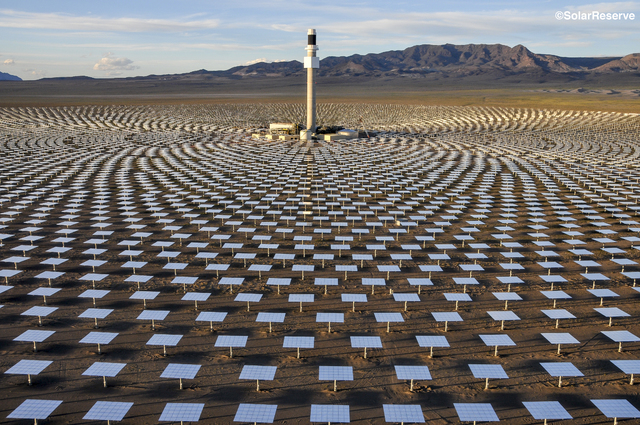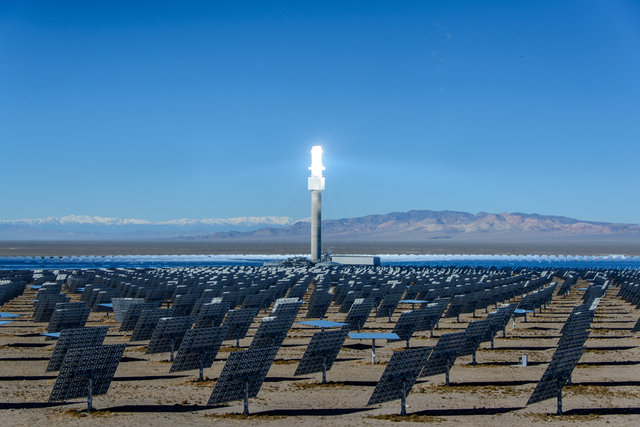Developer of huge solar array near Tonopah wants to build 10 more
A California-based energy company announced plans Tuesday to build the world’s largest solar project in Nevada, a $5 billion endeavor involving at least 100,000 mirrors and 10 towers as tall as any building in the state.
SolarReserve’s Sandstone project would include up to 10 concentrated solar arrays, each equipped with a molten salt system capable of storing the sun’s energy to generate power after dark, CEO Kevin Smith said.
The company already has built one such array, the 110-megawatt Crescent Dunes Solar Energy Plant, on 1,600 acres of federal land outside of Tonopah, 225 miles northwest of Las Vegas. The $1 billion array began delivering power to NV Energy late last year.
Smith said project Sandstone would generate between 1,500 and 2,000 megawatts, enough to supply about a million homes. That’s on par with a nuclear power plant or the Hoover Dam and far bigger than any of the world’s existing solar facilities.
“It’s a big project. It’s an ambitious project,” he said.
Smith expects to be able to announce a roughly 16,000-acre site for the new project within the next six to nine months. He said company officials have looked at about a dozen locations over the past year and narrowed the list to two, both on federal land in Nye County.
Construction probably won’t start for another two or three years, Smith said, but when it does, it should create about 3,000 jobs lasting about seven years, as the solar arrays and towers are built one or two at a time.
SolarReserve also will need to build new transmission infrastructure to carry its renewable product to market, he said.
Smith unveiled the new venture during an event Tuesday that drew U.S. Sen. Dean Heller, R-Nev., and Deputy Energy Secretary Elizabeth Sherwood-Randall to the Crescent Dunes plant in northwestern Nye County.
That facility uses more than 10,000 mirrored heliostats, each with the square footage of a small house, to focus sunlight on a 640-foot-tall central tower, heating the molten salt inside to more than 1,000 degrees.
The heat stored in the molten salt is then used to boil water, creating steam that drives generators to produce electricity day or night.
SolarReserve says its patented storage system allows Crescent Dunes to deliver power on demand like a coal, natural gas or nuclear plant, but with zero emissions, little water use and no hazardous waste.
The plant took more than four years to construct, significantly longer than company officials predicted. Smith expects both the cost and construction time to decrease significantly with each new facility SolarReserve builds.
He also expects to be able to pay for the new project with commercial financing, though he said his company will explore federal loan programs. Crescent Dunes was backed by $737 million in federal loan guarantees.
NV Energy agreed to buy that plant’s entire output at 13.5 cents per kilowatt hour — roughly twice the cost of power from a natural gas-fueled plant — for the next 25 years.
Smith said the bulk of the power from the Sandstone project likely will be “exported to the California market,” which is already awash in cheap solar power when the sun is out but has a growing need for renewable energy that can be delivered reliably day or night.
No power purchase agreements have been struck yet, but “we’ve certainly identified potential buyers,” he said.
Not everyone shares his optimism.
Some energy analysts have raised concerns about the large capital and maintenance costs associated with concentrated solar projects, particularly as comparatively cheap and easy-to-build photovoltaic arrays produce power at a lower cost.
Then there are the impacts of such massive projects on wildlife and the landscape.
Crescent Dunes in Nevada and the Ivanpah Solar Electric Generating System in California, just across the border from Primm, have made headlines and drawn the wrath of environmentalists for the number of birds that are killed in collisions with the mirrors and central towers or incinerated in beams of concentrated sunlight that can top 900 degrees.
But Smith believes the problem is overblown, especially at Crescent Dunes, where the full-time biologists on site have logged around 60 bird deaths over the past year.
“That’s probably less than the office building we work out of in Santa Monica,” he said.
Contact Henry Brean at hbrean@reviewjournal.com or 702-383-0350. Follow @RefriedBrean on Twitter.






















